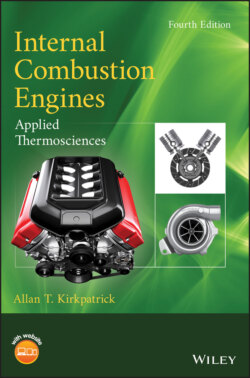Читать книгу Internal Combustion Engines - Allan T. Kirkpatrick - Страница 67
Solution
Оглавление1 The displacement volume isThe volume at bottom dead center isThe dimensionless energy addition isThe mass of gas in the cylinder is
2 The above engine parameters are entered into the FiniteHeatRelease.m program as shown below. The start of energy release is for Engine 1 and for Engine 2, and all other parameters are the same for both engines. function [ ] = FiniteHeatRelease( ) Gas cycle heat release code for two engines Engine input parameters: thetas(1,1) = -20; Engine 1 start of energy release (deg) thetas(2,1) = 0; Engine 2 start of energy release (deg) thetad(1,1) = 40; Engine 1 duration of energy release (deg) thetad(2,1) = 40; Engine 2 duration of energy release (deg) r =10; Compression ratio gamma = 1.4; Ideal gas const Q = 20.0; Dimensionless total energy addition a = 5; Wiebe efficiency factor a n = 3; Wiebe exponent n ...}The pressure profiles are compared in Figure 2.19. The pressure rise for Engine 1 is more than double that of Engine 2. The maximum pressure of about 8800 kPa occurs at 11 after top dead center for Engine 1, and at about 25 after top dead center for Engine 2. The temperature profiles are shown in Figure 2.20. Engine 1 has a peak temperature of about 2900 K, almost 400 K above that of Engine 2.
3 The start of energy release is varied from to , as shown in Figures 2.21 and 2.22, and the resulting thermal efficiency and imep are plotted.
Comment: The results indicate that there is an optimum crank angle for the start of energy release, which will maximize the thermal efficiency and imep. For this computation, the optimum start of energy release is about , resulting in a maximum thermal efficiency of about , and imep/ of about 13.2. At crank angles less than or greater than this optimal angle, the thermal efficiency and imep/ decrease.
Pressure profiles for Example 2.5. Temperature profiles for Example 2.5.
An explanation for the optimal crank angle is as follows. If the energy release begins too early during the compression stroke, the negative compression work will increase, since the piston is doing work against the increasing combustion gas pressure. Conversely, if the energy release begins too late, the energy release will occur in an increasing cylinder volume, resulting in lower combustion pressure, and lower net work. In practice, the optimum spark timing also depends on the engine load, and is in the range of to . The resulting location of the peak combustion pressure is typically between 5 and 15 atdc.
